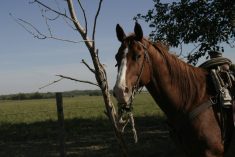Mention hops and the first thing that comes to mind is beer. But researchers with Agriculture Canada in Lethbridge want to expand hops’ limited identity beyond lagers and ales as they investigate whether hops can replace antibiotics on cattle feedlots.
Antibiotics such as Monensin, also known as Rumensin, kill bacteria species that inhibit the conversion of feed into energy and improve feed use in the rumen of cattle.
Hops possess similar anti-microbial properties, said Tim McAllister, who specializes in ruminant nutrition and microbiology with Agriculture Canada.
Read Also

Stacking Canada up on gene editing livestock
Canada may want to gauge how Argentina and other countries have approached gene editing in livestock and what that has meant for local innovation.
That’s why the herb has been used for centuries to preserve the shelf life of beer.
“There’s quite a movement in the (cattle) industry to try and identify natural plant compounds or natural additives that could replace some of the antibiotics that are presently used,” McAllister said.
He and his colleague Yuxi Wang fed hops to cattle at the Lethbridge research centre in 2008.
Researchers used funding from the Washington Hop Commission to purchase 60 steers and fed the animals a mixed ration of barley silage, barley grain and hops.
In a paper recently published in the journal, Livestock Science, the scientists concluded further study is needed, but preliminary results show feeding hops can increase steers’ average daily gain by six percent compared to a control group.
“Although there was a trend, statistically this is not significant,” said Wang, the lead author of the study, who explained that steers fed the highest concentration of hops appeared to use the barley more efficiently.
He is confident the six percent gain is valid and significant.
“Maybe not from a scientific perspective. But if you told producers you were going to increase performance by six percent, they’d find it (appealing),” he said.
“If you take this work to a commercial feedlot where they feed 25,000 head of cattle, that would be a big deal.”
In the study, Wang, McAllister and their colleagues fed the steers hop pellets during a 55-day growing diet and a 105-day finishing diet.
The animals were given 0 milligrams, 119 mg, 238 mg and 476 mg of hops per kilogram of dry matter during the 55-day growing diet and fed 0 mg, 238 mg, 476 mg or 952 mg of hops per kg of dry matter during the 105-day finishing period.
The scientists tracked the animals’ feed intake, average daily gain and feed efficiency and concluded, “there was a trend for steers fed the highest level of hops during the growing period and finishing period to exhibit higher ADG (average daily gain) as compared to those fed the control diet.”
Like McAllister, Wang believes hops alter the biochemistry of the cattle’s rumen and improve feed use.
“In this study, we used a low dosage (of hops),” said Wang, who noted that laboratory tests, conducted since the feedlot trial have shown that higher concentrations of hops further enhance ruminal fermentation and feed digestion.
Wang and McAllister would like to try the feedlot experiment again with larger amounts of hops to see if they get a larger response and to discover if hops are an economically viable alternative to anti-biotics.
At this point, the researchers don’t have funding for such a study.















